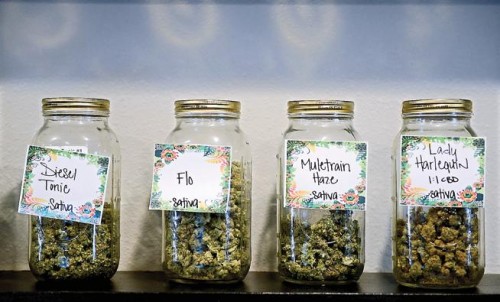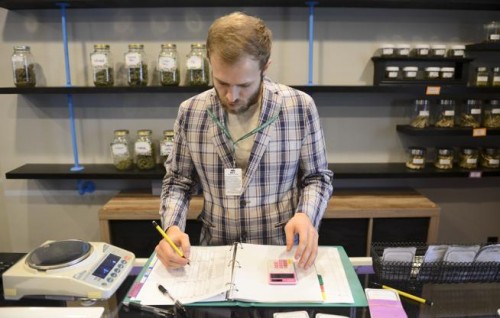BOULDER — In some circles, it’s the windfall that wasn’t.
More than $8.4 million has flowed into Boulder County communities thanks to tax revenue generated by the sale of marijuana since legal sales began two-and-a-half years ago.
And though the money has been welcome, it has not been the cash cow thousands of Coloradans had expected.
In Boulder, which has the most dispensaries of any city in the county at 11, the tax has generated more than $6.7 million since it began flowing statewide in 2014, according to the Colorado Department of Revenue and the city’s own revenue figures.
That amounts to about 1.75 percent of the city’s overall $367.2 million budget for 2015. Most of the cash goes into the city’s general fund.
The picture is much the same for Boulder County, which has seven dispensaries in unincorporated areas.
The county has received $1.83 million in tax revenue. That represents less than 1 percent of the county’s overall annual $426.6 million budget, and goes directly into the county’s general fund.
Dolla-dolla-bills: Related Colorado marijuana money news
Marijuana taxes to the rescue?: This Colorado city needs a new $7 million civic center
Tax boom: How the marijuana industry is boosting the Colorado economy
Five months into 2016: Colorado marijuana sales near half-billion mark
Weed news and interviews: Get podcasts of The Cannabist Show.
Subscribe to our newsletter here.
Watch The Cannabist Show.
Peruse our Cannabist-themed merchandise (T’s, hats, hoodies) at Cannabist Shop.
Revenues from Louisville and Lafayette are not released because those communities have such few stores that the sales tax figures are considered proprietary, according to the Colorado Department of Revenue.
Longmont, Erie and Superior do not allow pot sales.
The actual revenue picture is less rosy than the bounty voters expected when they approved the sale of recreational marijuana in 2012. At the time, it was billed as a financial boon to communities still reeling from the Great Recession.
But Joseph Henchman, a senior analyst with the nonpartisan Tax Foundation in Washington, D.C., said such perceptions aren’t unusual where new “sin” taxes are concerned.
“Some people thought we could repeal all of the other taxes it would be so lucrative,” Henchman said. “But nationwide it’s only a couple of billion dollars. And in terms of state tax revenue, it’s a drop in the bucket. It’s the same thing we see with lotteries. That revenue is viewed as the thing that will fund everything, even though typically it’s just 1 percent to 2 percent of overall revenue.”
Colorado marijuana tax revenues began flowing in 2014, with most cities and counties beginning collections in 2015 after they created zoning and other regulations associated with approving pot shops.
According to a new report by the Tax Foundation, which Henchman helped write, Colorado ranks second among the four states that have approved recreational sales nationwide. Washington state is ranked first, with a 37 percent overall rate, followed by Colorado, at 29 percent, and Alaska and Oregon, which have effective rates of 25 percent.
Shawn Coleman is government affairs director for Terrapin Care Station, one of the first corporate marijuana companies in the state. It operates stores in Boulder and Aurora. Coleman said the cash from tax revenues, even though it comprises a small share of overall government operating budgets, is about where the industry would like it to be.
“At 2 percent of (Boulder’s budget), it’s healthy. It shows it’s relevant and productive for the community. I don’t think we would want to see it at 10 percent,” Coleman said, because that would begin to indicate overuse in the community and raise concerns about health and law enforcement.
In 2015, Boulder used some of its $4.83 million marijuana tax windfall to help pay for open space, transportation, and parks and recreation. But the vast majority of the new cash, $3.73 million, went into the city’s general fund, a sort of catch-all for operating expenses.
Business advocates and some leaders believe Boulder could earn more if it regulates less, allowing its shops to stay open until 10 p.m., as the county allows, and allowing shops to offer customer loyalty programs and to advertise at public events.
A panel studying options is expected to make new recommendations this fall.
Andrea Meneghel, who represents the Boulder Chamber on the city’s Marijuana Advisory Panel, said Boulder may be missing out by not relaxing its approach to pot sales.

“When you look at these regulations — and we’re basically limiting our business from being open at the same operating hours as someone just outside the city limits — you’re losing that revenue, but not just during those operating hours,” Meneghel said. “You’re losing that customer, and that customer is building a relationship with another business. And you’re driving sales tax numbers out of Boulder.”
Even though the opportunity is there to seize more revenue, Boulder City Council members are wary of making policy choices based too much off of money.
“I think it’s a nice side benefit,” Mayor Suzanne Jones said, “but I think the driver should be to come up with regulations that work for Boulder’s community (read: don’t encourage kids to smoke weed) that don’t put our homegrown businesses at a disadvantage.”
Cities across the county and state have wrestled with whether to legalize pot sales and how to tax and regulate them. Longmont is eying whether to lift its ban this year, although no decisions have been made.
On a recent afternoon at Native Roots, a shop that operates just outside Longmont’s city limits, business was brisk, with the lobby packed and more than a dozen patrons waiting to buy marijuana products.
A man who asked only to be identified as “Tom” said he didn’t buy a lot of pot, but he didn’t mind the 29 percent tax rate. “I pay taxes on everything else I buy,” he said. “Why not weed? It’s a lot better than alcohol.”
He also said he hopes Longmont approves pot sales so that it can benefit from the tax collections. “Just about everybody here this afternoon lives in the city,” he said. “Why shouldn’t we get the benefit?”
Whether the cash generated by the new taxes justifies the work the state and local governments took on to regulate the industry and enforce new laws is difficult to determine.
Boulder, for instance, estimates that it spent nearly $250,000 on regulation and enforcement in 2015, significantly less than it took in via the new taxes.
In 2012, when the campaign to approve recreational pot was underway, one of its most appealing arguments was that millions of dollars in new tax revenue would flow to schools.
But officials at the St. Vrain Valley School District and the Boulder Valley School District said little if any cash has come their way, primarily because the state law is crafted to ensure poor school districts have the first shot at the money.
“We’ve received zero,” said Greg Fieth, chief finance officer for the St. Vrain schools. But the district, which is considering raising money via a new bonding campaign, has received dozens of questions from voters who wonder where all the pot money went.
“People ask us all the time how much the new marijuana tax will help,” he said. But because the district is battling growth issues, rather than stark poverty, it hasn’t qualified for the new cash.
“We knew the law would have minimal impact,” Fieth said.

Boulder Valley Schools have been able to tap some cash under the new law to help pay for education and prevention work around drug use. It’s received grants worth more than $550,000, according to Bill Sutter, chief finance officer for the Boulder Valley School District. But there is no cash for construction.
“People think marijuana tax revenues are fixing the school funding problem in Colorado. That is absolutely false,” he said. “These are supplemental funds only.”
Under state law, some $40 million is set aside to help repair and build new schools in poor districts. But one school serving 400 to 600 kids costs $45 million to build, Sutter said. The new tax money “is nowhere near enough to address the shortfall in capital funding. We’re hundreds of millions of dollars away from where we should be.”
As the state settles into its role as a hub for recreational and medical marijuana, sales tax revenue continues to rise, although growth is slowing. The Colorado Joint Budget Committee, a legislative panel that oversees state tax collections and spending, estimates that Colorado will collect $160.7 million during this fiscal year, which ends June 30. It will collect another $165 million the following year, an increase of just 2.6 percent.
In addition, the state plans to reduce its effective tax rate by 2 points next year in order to ensure that legal pot isn’t undersold by the black market, where tax-free transactions mean the pot costs nearly 30 percent less.
“The conflict is with the black market,” said Henchman, of the Tax Foundation. “It’s not like it exists only in Colorado and Washington. When there is a tax rate of 30 percent to 35 percent, you still have a sizeable black market. California (expected to vote on legalization later this year) is proposing a 15 percent rate. If it passes, it will be interesting to see what the black market looks like there.”
Regardless of how much new tax revenue the industry generates, Henchman said there is no going back. “It is the question I get asked most often by state lawmakers. ‘How does the tax work?'”
Last year, when he addressed a national meeting of lawmakers in Chicago, he asked how many thought their states would embrace the legal sale of recreational marijuana. In a room of 200 elected representatives, he said, “nearly all of them raised their hands.”
Jerd Smith: 303-473-1332, smithj@dailycamera.com or twitter.com/jerd_smith
